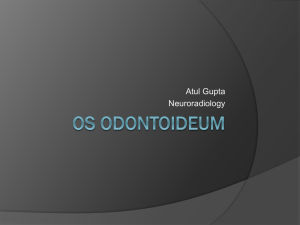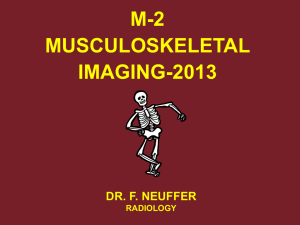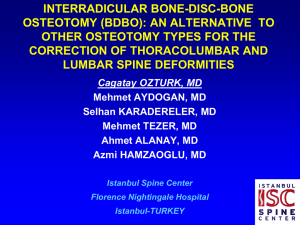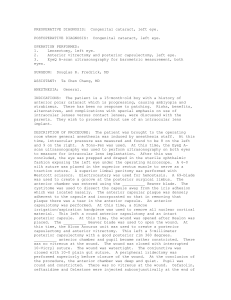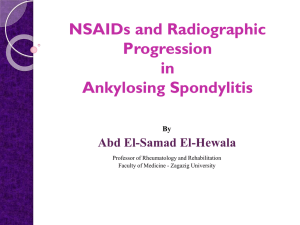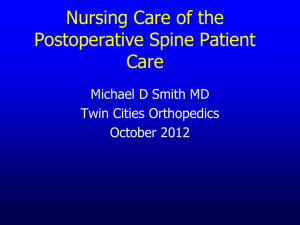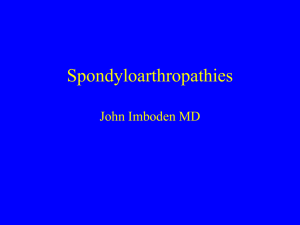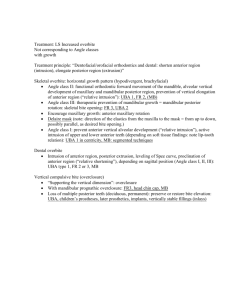Table 2. Level distribution of pseudoarthrosis
advertisement
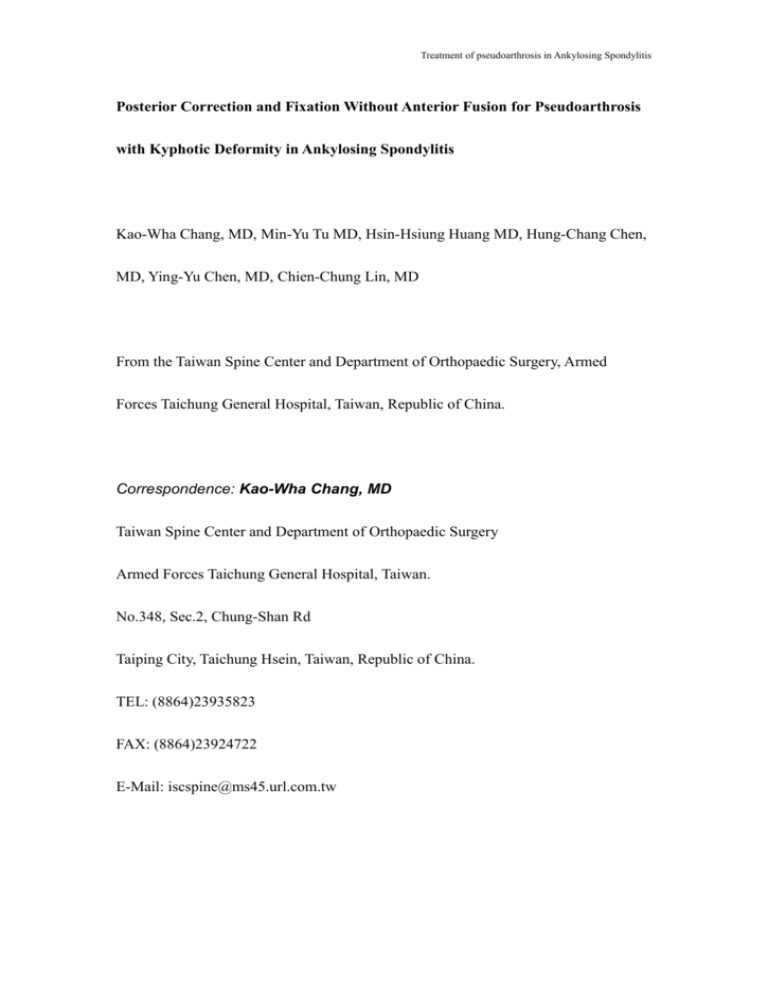
Treatment of pseudoarthrosis in Ankylosing Spondylitis Posterior Correction and Fixation Without Anterior Fusion for Pseudoarthrosis with Kyphotic Deformity in Ankylosing Spondylitis Kao-Wha Chang, MD, Min-Yu Tu MD, Hsin-Hsiung Huang MD, Hung-Chang Chen, MD, Ying-Yu Chen, MD, Chien-Chung Lin, MD From the Taiwan Spine Center and Department of Orthopaedic Surgery, Armed Forces Taichung General Hospital, Taiwan, Republic of China. Correspondence: Kao-Wha Chang, MD Taiwan Spine Center and Department of Orthopaedic Surgery Armed Forces Taichung General Hospital, Taiwan. No.348, Sec.2, Chung-Shan Rd Taiping City, Taichung Hsein, Taiwan, Republic of China. TEL: (8864)23935823 FAX: (8864)23924722 E-Mail: iscspine@ms45.url.com.tw Treatment of pseudoarthrosis in Ankylosing Spondylitis Study Design. Retrospective review. Objectives. To assess the effectiveness of posterior correction and fixation without anterior fusion for pseudoarthrosis with kyphosis in patients with ankylosing spondylitis (AS). Summary of Background Data. Anterior fusion is the current surgical treatment for pseudoarthrosis with kyphosis in AS. The unique characteristic in AS is the superior ability to bridge and fuse the large anterior opening-wedge gap created by posterior osteotomy to correct the kyphosis without anterior fusion after the osteotomy site is adequately fixed. This ability may persist even if pseudoarthrosis is present. Methods. Thirty consecutive patients with AS (mean age 41.7 years, range 29-55 years) underwent posterior correction and fixation without anterior fusion to treat pseudoarthrosis with kyphosis. Mean follow-up was 4.7 years (range 2.2-9.1 years). Radiographic and clinical results and complications were assessed. Results. Local kyphosis was substantially corrected from 45.5° (37-68°) to 7.5° (0-14°), with a mean correction of 38°. All patients had no evidence of nonunion on xray at the level of the pseudoarthrosis at final follow-up. None had a notable loss of correction. No major complication occurred. Three patients with neurologic deficits had postoperative improvement. Conclusion. Posterior correction and fixation is effective for managing Treatment of pseudoarthrosis in Ankylosing Spondylitis pseudoarthrosis with kyphosis in AS. No anterior fusion procedure was necessary. Key words: anterior fusion, posterior osteotomy, pseudoarthrosis, superior fusion ability. Introduction In ankylosing spondylitis (AS) the spine is vulnerable to trauma because of osteopenia and spinal rigidity. Relatively limited trauma may cause fractures, which are through the bone, and ligamentous disruptions through the disc space and facet joints. 1,2 These fractures may not heal, pseudoarthrosis may form.1-5 A pseudoarthrotic lesion can be a discovertebral lesion at the discovertebral junction or a destructive vertebral lesion within a vertebral body and is accompanied with a posterior weakness consisting of either a non-union fracture of the posterior elements or mobile facet joints.1,5-7 Pseudoarthrosis may cause deformity, severe back pain, and neurologic sequelae. Appropriate management depends on the patient’s clinical appreciation and on accurate radiologic diagnosis of the complication and its extent and severity. Anterior fusion is the current surgical procedure for pseudoarthrosis in patients with AS. Most surgeons believe that anterior fusion allows them direct access to the anterior lesion and that it is biomechanically superior to posterior fusion in a kyphotic spine7-9. Focal kyphosis can be corrected through an anterior approach but not the global kyphosis in the thoracic spine and loss of lumbar lordosis in patients with AS. Treatment of pseudoarthrosis in Ankylosing Spondylitis Most surgeons use a combined approach for treatment of pseudoarthrosis and correction of kyphotic deformity in patients with AS. Reviewing our experience in more than 200 patients with surgically treated AS kyphosis,10,11 we noted superior fusion ability without the need for anterior fusion. That is, satisfactory fusion of the large anterior gap was almost always achieved after the kyphosis was corrected with posterior opening-wedge osteotomy but without additional anterior fusion after the osteotomy site was adequately fixed. We believe that this method can also successfully treat pseudoarthrosis with kyphotic deformity in patients with AS. Therefore, the purpose of this study was to evaluate the effectiveness of posterior correction and fixation without anterior fusion in 30 patients with AS, pseudoarthrosis, and kyphotic deformity. To our knowledge, this method of treatment has not been described. Materials and Methods Between 1995 and 2003, 37 patients with AS and pseudoarthrosis, as confirmed with established clinical and radiographic criteria,12 were examined at our institution. Seven patients who had a more-or-less straight spine were excluded. Thirty patients presented with round thoracolumbar kyphosis of various degrees with the apex of kyphosis at the level of the pseudoarthrosis. The patients comprised 26 men and four Treatment of pseudoarthrosis in Ankylosing Spondylitis women with a mean age of 41.7 years (range 29-55 years). Mean follow-up was 4.7 years (range 2.2-9.1 years). The period between the onset of symptoms of AS and the radiographic detection of pseudoarthrosis was 2 to more than 20 years. All patients complained of back pain and progression of the kyphotic deformity. In all patients, these complaints were related to trauma. Standing anteroposterior and lateral radiographs were obtained before and immediately after surgery and at last follow-up. Radiographs were evaluated for pseudoarthrotic lesions, local kyphosis at the apex of kyphosis, and postoperative fusion (Table 1). Local kyphosis in the apical region was estimated as the angle between lines drawn from the posterior aspect of the two normal cranial vertebral bodices and lines drawn from the posterior aspect of two normal caudal vertebral bodies13(Figures 1, 2). Magnetic resonance imaging (MRI) or computed tomography (CT) was used to identify cord compression. Seventeen patients had canal encroachment in which the anteroposterior diameter of the spinal canal was markedly decreased. All had encroachment due to posterior extradural tissue resulting from inflammation of the ligamentum flavum and the facet joints, as well as from callus formation on the fractures of the posterior elements. Two of these patients had neurologic deficit of Frankle grade C, and one patient, Frankle D. Two of the 17 patients had small anterior Treatment of pseudoarthrosis in Ankylosing Spondylitis encroachment due to osteolysis of the anterior elements with small osteophytic formation in addition to posterior encroachment (Table 1). However, these two patients did not have neurologic symptoms. Gallium scanning was used to differentiate pseudoarthrosis from infection. Table 2 shows that most of the pseudoarthrotic lesions were near the thoracolumbar junction, with the highest being at T9-10 and the lowest at L2-3. All patients were treated with opening wedge osteotomy at the level of pseudoarthrosis for correction and with pedicle screws instrumentation for fixation. Apart for manual osteoclasis, which was omitted because of the pseudoarthrosis, the technique of opening wedge osteotomy was the same that described in our previous reports.10.11 No anterior spinal fusion procedures were performed in any patient. Results The three patients with neurologic deficit had postoperative improvement. The two patients with Frankle grade C and the one patient with Frankle grade D deficit before surgery improved to Frankle grade E, with normal strength and sensation after surgery. In all patients, the anterior vertebral lesions were extensive destructive lesions with a demonstrable weakness in the posterior elements of the affected segment Treatment of pseudoarthrosis in Ankylosing Spondylitis (Figure 1). Local kyphosis was substantially corrected from 45.5º (range 37-68º) to 7.5º(range 0-14º), with a mean correction of 38º (Table 1). No patient had any notable loss of correction between discharge and final follow-up. There was no evidence of nonunion on xray at the level of pseudoarthrosis at final follow-up (Figures 2, 3). No perioperative deaths or neurovascular complications occurred. One patient developed postoperative pneumonia, which was successfully treated with respiratory and antibiotic therapy. One superficial infection was treated with debridement and antibiotics, and it resolved uneventfully. Discussion A pseudoarthrotic lesion in AS can be a discovertebral lesion at the discovertebral junction or a destructive vertebral lesion within a vertebral body, depending on the initial injury is disruption of a disc space or fracture through a vertebral body. 1,5-7 Andersson first described discovertebral destructive lesions or spondylodiscitis occurring in AS in 1937.14 Cawley et al9 classified these lesions into localized central or peripheral discovertebral lesions and extensive central and peripheral discovertebral lesions. Whether inflammatory rather than mechanical factors play a role in the development of destructive intervertebral disc lesions has been debated.15 Localized lesions may occur, even early in the course of AS and Treatment of pseudoarthrosis in Ankylosing Spondylitis without a preceding trauma; this observation supports an inflammatory mechanism. Extensive discovertebral destruction occurs almost exclusively in patients with advanced ankylosis, and this is often preceded by trauma, which may be relatively trivial.9 Extensive vertebral lesions could occur within the body of a vertebra, if the initial injury is fracture through a vertebral body. Fang et al7 recommend that all such extensive destructive lesion be termed simply spinal pseudoarthrosis. In all of our patients, the anterior vertebral lesions were extensive destructive lesions with demonstrable weakness in the posterior elements of the affected segment, and the onsets were all related to injury. Spinal pseudoarthrosis is radiologically distinct as a condition with anterior-element osteolysis in the presence of a posterior-element weak link. It is clinically distinct as a lesion of management importance with respect to the persistent and painful symptoms, the progression of preexisting kyphotic deformity, the likelihood of progressive myelopathy,16 and the surgical implications. Most surgeons recommended anterior fusion for pseudoarthrosis with kyphotic deformity in patients with AS. They believe that anterior fusion allows them direct access to the anterior lesion and that it is biomechanically superior to posterior fusion in a kyphotic spine.7-9 The thoracolumbar region in patients with AS and kyphosis contains the segments most susceptible to shearing or distraction. A fracture is most likely to occur at such a Treatment of pseudoarthrosis in Ankylosing Spondylitis site of concentrated stress, and the resultant long-level arm of motion makes spontaneous healing difficult. Pseudoarthrosis most commonly occurs at the thoracolumbar region of T11-L1, as observed in 77% of our patients. Anterior surgery around the thoracolumbar junction usually requires the surgeon to enter the chest and detach the diaphragm; however, older patients cannot always tolerate this approach. In addition, with an anterior procedure alone, correction of the kyphotic deformity in AS is impossible and dangerous because of the possible neurologic complications. The unique characteristic of AS is its superior fusion ability. According to our work, the large anterior opening wedge created with posterior osteotomy to correct the thoracolumbar kyphosis can almost always achieve solid fusion without an anterior fusion procedure after the osteotomy site is adequately fixed.10,11 We believe this is also the case in the presence of pseudoarthrosis. We observed no evidence of nonunion on xray at all anterior gaps created in the pseudoarthrosis during posterior correction at final follow-up; this finding proves the reliability of this method. We believe that fixation is the most important factor in achieving fusion in the AS spine. The sequence of progression in AS is from an ankylosing spine to a calcified bamboo spine. The former is actually a kind of biologic fixation. All of the soft tissue between the bones, including ligaments, discs, and joints, gradually fuse after biologic fixation. Our previous studies10,11 and this study demonstrated that no Treatment of pseudoarthrosis in Ankylosing Spondylitis evidence of nonunion on xray was found at all gaps between vertebral bodies created by posterior opening-wedge osteotomy after the osteotomy site was rigidly fixed by using pedicle screws. Of course, the correction of kyphosis to reduce shearing and distraction forces and to improve the biomechanical environment for fusion might be other important factors for obtaining fusion. We used opening wedge osteotomy at the level of pseudoarthrosis to correct the deformity for two reasons. First, the use of closing wedge osteotomy (a spine-shortening procedure) to achieve a mean kyphotic correction of 38º in the lower thoracic or thoracolumbar spine would be dangerous in terms of spinal shortening and possible cord compression and damage.17 Second, the vertebral column at the site of the pseudoarthrosis was already fractured; therefore, the procedure of manual osteoclasis could be omitted. Thus, the procedures of opening wedge osteotomy were simplified and easily accomplished. As Kanefield et al18 pointed out, fractures in AS are easily overlooked, and nonunion occurs with a resultant build-up of fibrous pseudoarthrosis tissue. This build-up progressively compresses the spinal cord and nerve roots, producing a central neurogenic type of pain that may radiate to the legs and that may or may not be associated with paralysis of the bladder and the extremities. Patients with these symptoms may require anterolateral decompression and fusion to recover function Treatment of pseudoarthrosis in Ankylosing Spondylitis and gain stability and to relieve pain. We used MRI or CT to identify cord compression. MRI is valuable in this assessment. However, kyphosis related to AS is sometimes severe and leads to difficulties in positioning the patient in the MRI unit. Their spine may be some distance from the coil, which often causes suboptimal visualization of the region of interest. In such instances, we have found CT in the lateral decubitus position to be useful. We apply sagittal reconstruction as necessary, though certainly the detail of the vascular fibrous tissue is not visualized as clearly as it is on MRI. Seventeen patients had canal encroachment, and three had neurologic symptoms, but none of these patients had encroachment due to anterior fibrous pseudoarthrosis tissue, as Kanefield el at described.18 Only two of the 17 patients had small anterior osteophytes, but they had no neurologic symptoms. All 17 had encroachment due to posterior extradural tissue, including hypertrophy of the ligamentum flavum and the facet joints and callus formation on posterior-element fracture; this can be easily removed with posterior opening-wedge procedures. The three patients with neurologic deficits recovered function after posterior opening-wedge osteotomy without anterior decompression. Correction of kyphosis, which results in posterior migration of the spinal cord away from the apex to diminish tension on spinal cord,19 and fixation of the unstable AS spine due to pseudoarthrosis may be other possible mechanisms for Treatment of pseudoarthrosis in Ankylosing Spondylitis neurologic recovery. We used to use the technique13 described in this study to measure local kyphosis for fractures which result in angular kyphosis within a round kyphosis. Basing on the following three reasons, we only measure local kyphosis rather than local and global kyphosis to evaluate correction and loss of correction at the site of osteotomy and pseudoarthrosis as evidence of nonunion at that site. First, in our previous studies10,13 , correction of local kyphosis correlates well with correction of global kyphosis. Improvement of local sagittal alignment represents a positive effect on global alignment and balance. Second, according to McMaster and Corventry report20 and our study10, the "disease" ankylosing spondylitis at sites other than the osteotomy site could allow for increased flexion deformity and detract from the initial correction of global alignment and balance during follow-up. In another word, loss of correction of global kyphosis does not mean loss of correction at the site of osteotomy and pseudoarthrosis and can not be an evidence of nonunion at that site. Third, the purpose of this study is not to demonstrate how much correction can be obtain by opening wedge osteotomy. Opening wedge osteotomy enable substantial correction for AS kyphosis has been demonstrated in numerous reports including ours10. This study is try to demonstrate a preexisting pseudoarthrosis at the site of osteotomy can obtain fusion by the superior fusion ability in AS patients and fixation without Treatment of pseudoarthrosis in Ankylosing Spondylitis anterior fusion procedures. No any notable loss of correction at the site of osteotomy and pseudoarthrosis in the follow-up can be an important piece of evidence of union at that site. In summary, because of its superior fusion ability in AS, posterior opening wedge osteotomy and fixation can successfully treat pseudoarthrosis with kyphosis in patients with AS. Anterior fusion procedures were not required to achieve fusion in our patients. Treatment of pseudoarthrosis in Ankylosing Spondylitis Key points Anterior fusion is the current surgical treatment for pseudoarthrosis with kyphosis in patients with AS. The unique characteristic in AS is its superior fusion ability. Pseudoarthrosis with kyphosis in AS can be effectively treated with posterior correction and fixation without anterior fusion. Treatment of pseudoarthrosis in Ankylosing Spondylitis References 1. Chan FL, Ho EKW, Chau EMT. Spinal pseudoarthrosis complicating ankylosing spondylitis.: comparison of CT and conventional tomography. AJR Am J Roentgenol 1988;150:611-9. 2. Gelman MI, Umber JS. Fractures of the thoracolumbar spine in ankylosing spondylitis. AJR Am J Roentgenol 1978;130:485-93. 3. Dilorio G, Sundaram M. Fracture with pseudoarthrosis in ankylosing spondylitis. Orthopedics 1990;13:118-25. 4. Hunter T, Dubo HIC. Spinal fractures complicating ankylosing spondylitis. Arthritis Rheum 1983;26:751-9. 5. Pastershank SP, Resnick D. Pseudoarthrosis in ankylosing spondylitis. J Can Assoc Radiol 1980;31:234-42. 6. Hung CT, Yng ST, Han NT. Pseudarthrosis and pseudopseudarthrosis of ankylosing spondylitis: report of 2 cases. Chinese Med J 1992;50:500-91. 7. Fang D, Leong JCY, Ho E. Spinal pseudoarthrosis in ankylosing spondylitis. J Bone Joint Surg 1988;70B:443-7. 8. Yan AC, Chan RNW. Stress fracture of the fused lumbo-dorsal spine in ankylosing spondylitis. J Bone Joint Surg 1974;56B:681-7. 9. Cawley MID, Chalmers TM, Kellgren JH. Destructive lesions of vertebral bodies in ankylosing spondylitis. Ann Rheum Dis 1972;31:355-8. 10. Chang KW, Chen YY, Lin CC. Closing wedge osteotomy VS opening wedge osteotomy in ankylosing spondylitis with thoracolumbar kyphosis. Spine 2005;30:1584-93. 11. Chang KW, Chen YY, Lin CC. Sagittal translation in opening wedge osteotomy Treatment of pseudoarthrosis in Ankylosing Spondylitis for correction of thoracolumbar kyphosis in ankylosing spondylitis. Spine 2005; in press. 12. Chan FL, Ho EKW, Fang D. Spinal pseudoarthrosis in ankylosing spondylitis. Acta Radiol 1987;28:383-8. 13. Chang KW, Chen YY, Lin CC. etal. Apical lordosating osteotomy and minimal segment fixation for the treatment of thoracic or thoracolumbar osteoporotic kyphosis. Spine 2005;30:1674-81. 14. Andersson O. RÖntgenbilden vid spondylarthritis ankylopoetica. Nord Med Tidskr 1937;14:2002-2. 15. Rasker JJ, Prevo RL, Lanting PJH. Spondylodiscitis in ankylosing spondylitis. inflammation or trauma? Scand J Rheumatol 1996;25:52-7. 16. Good AE, Keller TS, Weatherbee L. Spinal cord block with a destructive lesion of the dorsal spine in ankylosing spondylitis. Arthritis Rheum 1982;25:218-25. 17. Kawahara N, Tomita K, Kobayashi T. Influence of acute shortening on the spinal cord. Spine 2005;30:613-20. 18. Kanefield DG, Mullins BP, Freehafer AA. et al. Destructive lesions of the spine in rheumatoid spondylitis. J Bone Joint Surg 1969;51A:1369-75. 19. Batzdorf U, Batzdorf A. Analysis of cervical spine curvature in patients with cervical spondylosis. Neurosurgery 1988;22:827-36. 20. McMaster MJ, Coventry MB. Spinal osteotomy in ankylosing spondylitis : technique, complications, and long-term results. Mayo Clin Proc 1973;48:476-87. Treatment of pseudoarthrosis in Ankylosing Spondylitis Table 1. Radiographic Data A: Types of lesions Lesion No. of Patients Local kyphosis 30 Pseudoarthrotic lesion Extensive discovertebral lesion 30 Fracture in the posterior element 30 Canal encroachment Posterior encroachment 17 Anterior encroachment 2 B: Degree of kyphosis Local kyphosis Mean º (range) Preoperative 45.5 (37-68) Immediate postoperative 7.5 (0-14) Final follow-up 9.5 (1-16) Correction 38 (31-58) Loss of correction 2.0 (1-6) Treatment of pseudoarthrosis in Ankylosing Spondylitis Table 2. Level distribution of pseudoarthrosis Level No. of Lesions (n = 30) T9-10 1 T10-11 3 T11-12 13 T12-L1 10 L1-2 2 L2-3 1 Treatment of pseudoarthrosis in Ankylosing Spondylitis Figure legends Figure 1. Typical pseudoarthrotic lesion with kyphosis in a patient with AS. Image shows an extensive and destructive anterior discovertebral lesion with nonunion fracture of the posterior elements of the affected segment at the kyphotic apex. Figure 2. 33-year-old man with painful, round kyphosis. (A) Apex at T11-12 was due to AS with pseudoarthrosis. Local kyphosis is 44º. (B) Two months after surgery, normal sagittal alignment is restored. Local kyphosis is 7º. (C) At 2 years, pseudoarthrosis has fused with no loss of correction. Figure 3. 47-year-old man with progressive, painful round kyphosis. (A) Apex at T11-12 was due to AS with pseudoarthrosis. Local kyphosis is 55º. (B) At 2 months after surgery, normal sagittal alignment is restored. Local kyphosis is 6º. (C) At 2 years, pseudoarthrosis has fused with no loss of correction. Treatment of pseudoarthrosis in Ankylosing Spondylitis Fig 1 Treatment of pseudoarthrosis in Ankylosing Spondylitis Fig 2A Treatment of pseudoarthrosis in Ankylosing Spondylitis Fig 2B Treatment of pseudoarthrosis in Ankylosing Spondylitis Fig 2C Treatment of pseudoarthrosis in Ankylosing Spondylitis Fig 3A Treatment of pseudoarthrosis in Ankylosing Spondylitis Fig 3B Treatment of pseudoarthrosis in Ankylosing Spondylitis Fig 3C


